These rules have been taken from Backgammon Galore, and have been handpicked to provide the best overview, understanding and gameplay as possible when playing Backgammon in Ultima Online. Major differences between "in-game" and "real-life" backgammon play have been noted in pink among the rules. Example of how important differences in rules will look like.
Backgammon
Backgammon is a game of luck and skill. It is played by two people with 15 checkers each on a board consisting of 24 spaces or points. The checkers are moved according to rolls of the dice. Each player tries to bring his own checkers home and bear them off before his opponent does, hitting and blocking the enemy checkers along the way.
Backgammon has been around a long time, with origins dating back possibly 5000 years. The ancient Greeks played. So did the Romans. The game we know today was refined in England in the seventeenth century, which is also when it acquired the name backgammon.
Rules of Backgammon
The rules of backgammon are simple and easy to learn. In fact, it is quite remarkable that a game as rich and interesting as backgammon has such a simple set of rules. Here are the complete rules, with diagrams showing how to set up the board and move the pieces.
Setup
Backgammon is a game for two players, played on a board consisting of twenty-four narrow triangles called points. The triangles alternate in color and are grouped into four quadrants of six triangles each. The quadrants are referred to as a player's home board and outer board, and the opponent's home board and outer board. The home and outer boards are separated from each other by a ridge down the center of the board called the bar. Although this bar is non existent in Ultima Online, the theory of the game, the quadrants and the home and outer boards is still applicable.

Figure 1. A board with the checkers in their initial position. An alternate arrangement is the reverse of the one shown here, with the home board on the left and the outer board on the right.
The points are numbered for either player starting in that player's home board. The outermost point is the twenty-four point, which is also the opponent's one point. Each player has fifteen checkers of his own color. The initial arrangement of checkers is: two on each player's twenty-four point, five on each player's thirteen point, three on each player's eight point, and five on each player's six point.
Object of the Game
The object of the game is move all your checkers into your own home board and then bear them off. The first player to bear off all of their checkers wins the game.

Figure 2. Direction of movement of White's checkers. Red's checkers move in the opposite direction.
Movement of the Checkers
To start the game, each player throws a single die. This determines both the player to go first and the numbers to be played. In Ultima Online this would be equivalent of both players throwing both dice. This would determine the player to go first, but not the numbers to be played. If equal numbers come up, then both players roll again until they roll different numbers. The player throwing the higher number now moves his checkers according to the numbers showing on both dice. In Ultima Online this would mean that the player throwing the highest total sum of both dice would start the game, but with a new roll of both dice. After the first roll, the players throw two dice and alternate turns.
The roll of the dice indicates how many points, or pips, the player is to move his checkers. The checkers are always moved forward, to a lower-numbered point. The following rules apply:
- [1] A checker may be moved only to an open point, one that is not occupied by two or more opposing checkers.
[2] The numbers on the two dice constitute separate moves. For example, if a player rolls 5 and 3, he may move one checker five spaces to an open point and another checker three spaces to an open point, or he may move the one checker a total of eight spaces to an open point, but only if the intermediate point (either three or five spaces from the starting point) is also open.

Figure 3. Two ways that White can play a roll of [5] [3].
[3] A player who rolls doubles plays the numbers shown on the dice twice. A roll of 6 and 6 means that the player has four sixes to use, and he may move any combination of checkers he feels appropriate to complete this requirement.
[4] A player must use both numbers of a roll if this is legally possible (or all four numbers of a double). When only one number can be played, the player must play that number. Or if either number can be played but not both, the player must play the larger one. When neither number can be used, the player loses his turn. In the case of doubles, when all four numbers cannot be played, the player must play as many numbers as he can.
Hitting and Entering
A point occupied by a single checker of either color is called a blot. If an opposing checker lands on a blot, the blot is hit and placed on the bar.
Any time a player has one or more checkers on the bar, his first obligation is to enter those checker(s) into the opposing home board. A checker is entered by moving it to an open point corresponding to one of the numbers on the rolled dice.
For example, if a player rolls 4 and 6, he may enter a checker onto either the opponent's four point or six point, so long as the prospective point is not occupied by two or more of the opponent's checkers.

Figure 4. If White rolls [6] [4] with a checker on the bar, he must enter the checker onto Red's four point since Red's six point is not open.
If neither of the points is open, the player loses his turn. If a player is able to enter some but not all of his checkers, he must enter as many as he can and then forfeit the remainder of his turn.
After the last of a player's checkers has been entered, any unused numbers on the dice must be played, by moving either the checker that was entered or a different checker.
Bearing Off
Once a player has moved all of his fifteen checkers into his home board, he may commence bearing off. A player bears off a checker by rolling a number that corresponds to the point on which the checker resides, and then removing that checker from the board. Thus, rolling a 6 permits the player to remove a checker from the six point.
If there is no checker on the point indicated by the roll, the player must make a legal move using a checker on a higher-numbered point. If there are no checkers on higher-numbered points, the player is permitted (and required) to remove a checker from the highest point on which one of his checkers resides. A player is under no obligation to bear off if he can make an otherwise legal move.

Figure 5. White rolls [6] [4] and bears off two checkers.
A player must have all of his active checkers in his home board in order to bear off. If a checker is hit during the bear-off process, the player must bring that checker back to his home board before continuing to bear off. The first player to bear off all fifteen checkers wins the game.
Gammons and Backgammons
At the end of the game, if the losing player has borne off at least one checker, he loses only one point. However, if the loser has not borne off any of his checkers, he is gammoned and loses two points. Or, worse, if the loser has not borne off any of his checkers and still has a checker on the bar or in the winner's home board, he is backgammoned and loses three points.
Irregularities
- [1] A turn is completed when the player picks up his dice. In Ultima Online this would mean for the player to say either "done", "k", or another phrase that notifies the opponent that the player has completed his turn. If the play is incomplete or otherwise illegal, the opponent has the option of accepting the play as made or of requiring the player to make a legal play. A play is deemed to have been accepted as made when the opponent rolls his dice.
[2] If a player rolls before his opponent has completed his turn by picking up the dice, the player's roll is voided. In Ultima Online this would be before the opponent has said either "done", "k", or another phrase that notifies the player of the opponent having completed his turn.
Backgammon FAQ
Q: Can I pass when it's my turn?
No, you must play your roll if there is any legal way to do so. If you can't play all of your numbers, you must play as many as you can. So if you roll [6] [6] and can only play three of your four 6's, that's what you must do.
Q: Can I play one number in such a way as to avoid playing the other?
No, you must play both numbers of a roll if possible. Sometimes this means having to make a move you don't like so that your other number can also be played.
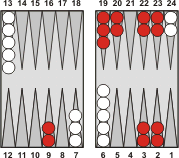
Whites rolls [6] [4]: White can't play 13/7 with his [6] because that would leave no way to play the [4]. Instead, he must play 24/18, allowing him to play 18/14 with the [4].
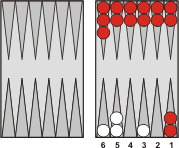
Whites rolls [6] [4]: As much as he would like to, White cannot bear off the checker on the six-point! He must play 6/2, using his [4] first, and then use the [6] to take a checker off the five-point.
Q: What if I can only play one number?
If you can play one number but not both, then you must play the higher one.
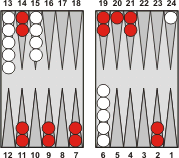
Whites rolls [6] [4]: The only checker White can move is his runner. The rules say he must to the 18-point using the [6] rather than hit on the 20-point using the [4].
Q: Is hit-and-run allowed (also known as "pick and pass")?
Yes, if you hit a checker, you are allowed to run your hitter to safety. Here is an example:
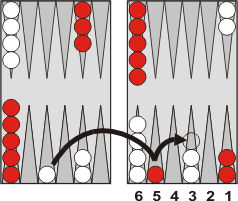
Whites rolls [5] [2]: White may hit Red's checker on the five-point and then move his hitter to safety on the three-point.
Q: Is it ok to have more than five checkers on a point?
Yes, you may place as many checkers as you want on a point. Pile them one on top of another if you run out of room.
Q: Can I play low number first when bearing off?
Yes, you may play your numbers in either order, as long as each number is played legally. Using your low number first can sometimes get you out of a sticky situation. Here are some examples:
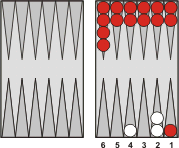
Whites rolls [4] [1]: If White plays [4] first, he takes the checker off the four-point and is forced to hit with the [1], leaving two blots. But if he plays the [1] first, moving from the four-point to the three-point, he can then use the [4] to remove the checker from the three-point. This wastes a pip, but it leaves no shots.
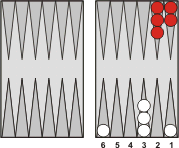
Whites rolls [5] [4]: If White plays his [5] first, he ends up with a gap on his two-point—not good if he rolls a [2] later. If he plays the [4] first, he fills the gap on the two-point and increases his chances of getting off in two more rolls.
If you have any further Questions about the Rules of Backgammon, please post them here and they will be answered.
I have intentionally left out any information and rules regarding the "doubling cube", I do not think this is applicable in a good manner in Ultima Online, nor do I like it. Although if players are interested there is further information and rules located here. - Safir
You can also play backgammon in your web browser against a computer opponent. Either to practice, or for fun. Try Motif Backgammon here!
(requires Java)
Make sure to visit The Humble Gambling Shack and Tavern of Awesome!
Happy gaming and gambling!
// Safir




